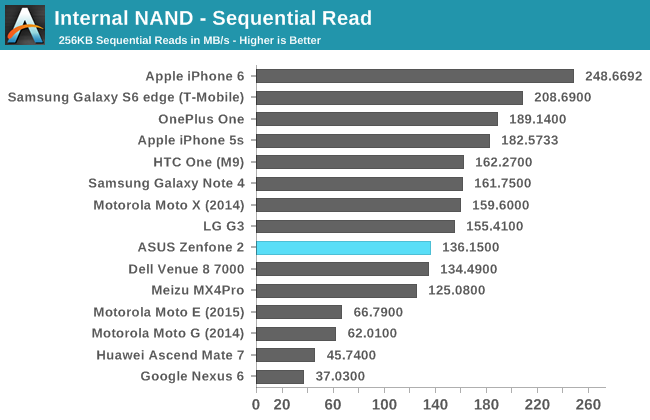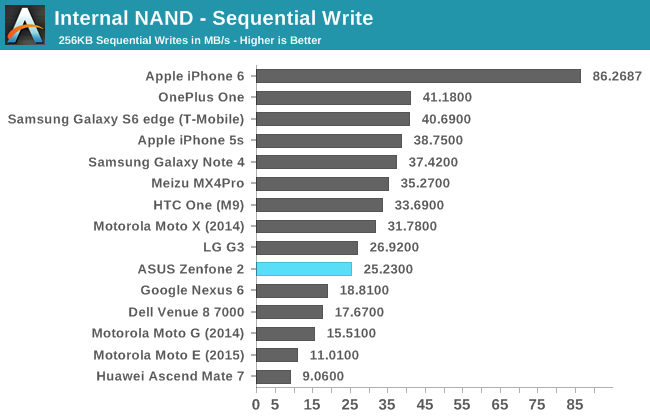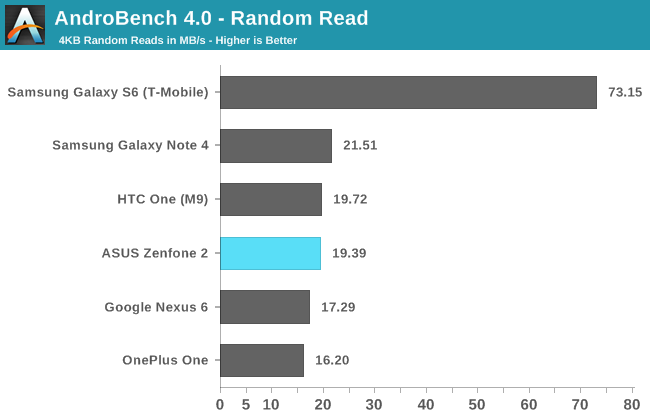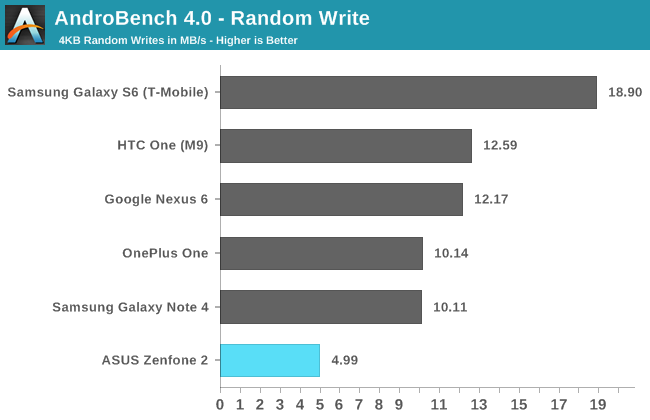The ASUS ZenFone 2 Review
by Brandon Chester on May 26, 2015 8:00 AM ESTNAND Performance
While it's not disclosed by manufacturers, the speed of NAND on a smartphone is a very important aspect of overall smartphone performance. It has an impact on how long cameras can do burst capture, and how well the phone performs when apps are running both in the foreground and the background. To evaluate the NAND performance of the ZenFone 2 I've run it through both of our internal storage benchmarks. Because our iOS benchmark only supports a single IO thread, we'll be using our older storage benchmark alongside the newer Androbench 4.0 test for the foreseeable future.




In our original single threaded storage benchmark the ZenFone 2 is decidedly average in its performance. In every case it's either slightly above or below the median result on our charts. It's important to keep in mind that this test puts devices like the Galaxy S6 with its UFS storage at a disadvantage, as its NAND can make use of several IO threads due to the use of a command queue.




In our newer AndroBench 4.0 storage test we see that the ZenFone 2 ends up falling farther behind the other devices that we've run through the test. In the sequential read test it's not the slowest device, but that's only due to the Nexus 6 being extremely far behind every other device as a result of Google's full disk encryption. In the sequential write and random read tests it's comes behind the HTC One (M9), although to a very small degree in the latter test. Random writes are where it really stumbles, with a speed that's less than half of the next slowest device.
I'm not sure whether I can attribute it to the enormous amount of RAM that the 4GB version of the ZenFone 2 can use as a cache, but I never noticed any issues with performance as a result of IO operations being run either by the app I was using or by another application in the background. Even when updating applications, performance remained consistent.










147 Comments
View All Comments
quiksilvr - Tuesday, May 26, 2015 - link
I bought a third party Qualcomm Quick Charge 2.0 charger for $15 on Amazon for my Zenfone 2 and it works just fine.http://www.amazon.com/dp/B00OVD3FEU/
grusin123 - Tuesday, May 26, 2015 - link
Camera review focuses just on the asus camera app, which clearly is the weak point. Could you please test it with google camera app? you can download it or any kitkat+ device.It would be interesting to see how it compares against nexus 5 and 6, which both use google camera app.
Kepe - Tuesday, May 26, 2015 - link
Using a different camera app doesn't fix problems with the ISP. Camera apps don't process images, the ISP does. Well, some camera apps may do some extra post-processing after the ISP has done its processing, but still if the ISP oversharpens the images in the "opimized" mode and leaves them blurry in the "no optimizations" mode, there's very little a different camera app could do to change image quality in any significant way. You'll probably end up with less choice for camera settings using a 3rd party camera app, because an app made by someone else probably doesn't know about the "optimized" and "nonoptimized" modes the ASUS camera has.A camera app basically just tells the phone to take a picture with a certain set of parameters, and those parameters are within the same limits no matter what app you use. Some apps may have settings that seem to exceed what the OG app has, but those are usually just some software tricks that make horrible looking images. For example, I've got an app that lets me choose a 20s exposure time, but using that makes images horribly grainy, causes weird light effects and as such produces images that are completely useless. Max exposure in the original camera app is 1s, so the other app probably tries to take multiple images and combine them to a single one, or then it records a 20s video and compresses that into a single image. It's similar with apps that let me choose a higher ISO level than what is offered by the original app. They just use software post-processing to brighten the image after it has been taken.
Kepe - Tuesday, May 26, 2015 - link
*optimized. Still need an edit button... How hard can it be?tmc - Tuesday, May 26, 2015 - link
Can you please comment on cell signal reception? Possibly compare with other phones as well - like you have done for other features. The reason I am asking is that - a new phone (not mentioning the device/brand) that I purchased has like approx 10dBm lower reception than my earlier device (nexus 4) - and this significantly affects LTE. Where I used to get LTE, now I don't. I would think cell reception should be a very important criterion. Thanks.Brandon Chester - Tuesday, May 26, 2015 - link
It didn't seem to be any worse or better than other devices. For reference, I put the phones in a certain spot in order to make sure the LTE signal is strong during the battery life test. The signal strength was basically the same as the iPhone 5s or the Galaxy S6 in that same spot.tmc - Tuesday, May 26, 2015 - link
Thanks. That helps.velanapontinha - Tuesday, May 26, 2015 - link
Hi, Brandon.Any ETA on the review of the "regular" MX4? MWC is long over.
AnandTech still doesn't have one single review of a Mediatek based device. Mediatek is no longer a Cyrix kind of thing, you guys should give it the spotlight it is starting to deserve.
Maxpower2727 - Tuesday, May 26, 2015 - link
I hate to be "that guy," but....G4 review?re2onance - Tuesday, May 26, 2015 - link
Thanks for the detailed review of the battery life. Did you use the Asus web browser or Google Chrome for the web browsing battery test?